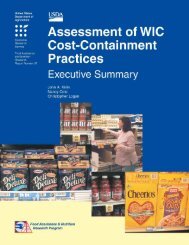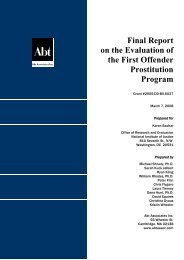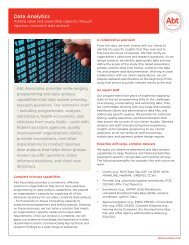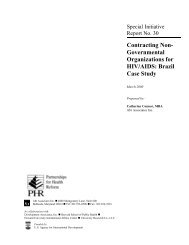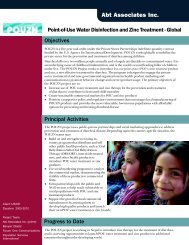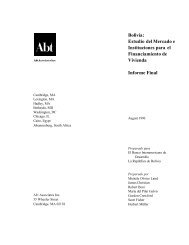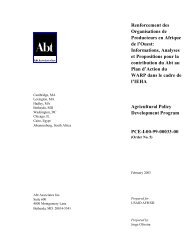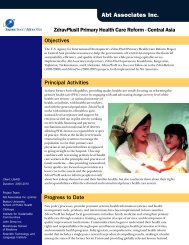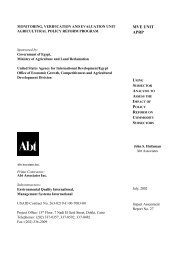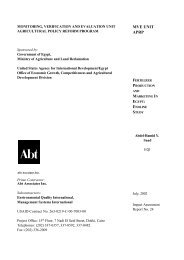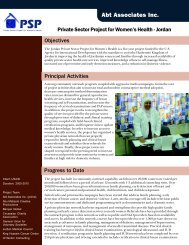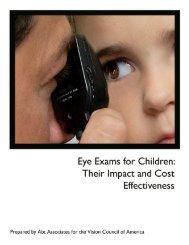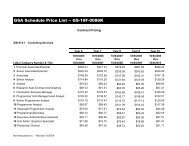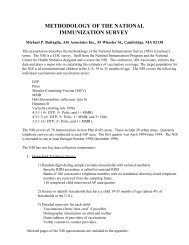What America's Users Spend on Illegal Drugs 1988-2000 - National ...
What America's Users Spend on Illegal Drugs 1988-2000 - National ...
What America's Users Spend on Illegal Drugs 1988-2000 - National ...
- No tags were found...
You also want an ePaper? Increase the reach of your titles
YUMPU automatically turns print PDFs into web optimized ePapers that Google loves.
dynamics of emergency room use by chr<strong>on</strong>ic cocaine and heroin users, but some speculati<strong>on</strong> might be helpful.According to the 1997 DAWN (Drug Abuse Warning Network) report, dependence is the dominant drug usemotive for heroin and cocaine users seeking emergency room assistance: 86 percent for heroin menti<strong>on</strong>s and68 percent for cocaine menti<strong>on</strong>s. Chr<strong>on</strong>ic effects, withdrawal or seeking detoxificati<strong>on</strong> are the typical reas<strong>on</strong>sfor going to the emergency room: 62 percent for heroin menti<strong>on</strong>s and 50 percent for cocaine menti<strong>on</strong>s. 27Addicts are more likely to seek treatment as they age, and treatment episodes seem to become more frequentover time. 28 For this reas<strong>on</strong> al<strong>on</strong>e, we would expect to see emergency room menti<strong>on</strong>s increase even if thenumber of chr<strong>on</strong>ic heroin and cocaine users did not change. Furthermore, we suspect that chr<strong>on</strong>ic heroin andcocaine users will develop an increasing number of chr<strong>on</strong>ic health c<strong>on</strong>diti<strong>on</strong>s as they age and as theiraddicti<strong>on</strong>s advance. This, too, can account for an increase in emergency room menti<strong>on</strong>s. Our own calculati<strong>on</strong>suggest that annual ER menti<strong>on</strong>s have grown from about 4 per hundred chr<strong>on</strong>ic users in the late 1980s to about7 per hundred chr<strong>on</strong>ic cocaine users in the late 1990s; for chr<strong>on</strong>ic heroin use, annual ER menti<strong>on</strong>s have grownfrom about 4 per hundred to about 9 per hundred. While DAWN is valuable for detecting short-term changesin specific jurisdicti<strong>on</strong>s, such as a spike in overdose deaths, it would seem to have little or no value as a toolfor m<strong>on</strong>itoring l<strong>on</strong>g-term trends in the prevalence of substance abuse.Average Amount Spent <strong>on</strong> Cocaine and HeroinDUF interviewers from 1989 and later asked resp<strong>on</strong>dents how much they spent <strong>on</strong> drugs during a week. Thequesti<strong>on</strong> did not separate cocaine from heroin spending or exclude other drugs, so we must infer how muchwas spent <strong>on</strong> cocaine and how much was spent <strong>on</strong> heroin. Also, some resp<strong>on</strong>dents gave answers that wereimplausibly large, so based <strong>on</strong> the methodology explained in the Appendix, we adjusted estimates to moderatethe effect of extreme values. Because of a change in questi<strong>on</strong>naire design, DUF does not provide comparableestimates after 1995. The Appendix explains how we dealt with these problems. Table 4 provides estimatesof the average expenditure <strong>on</strong> cocaine and heroin. All estimates were c<strong>on</strong>verted to <strong>2000</strong> dollar equivalentsbased <strong>on</strong> the c<strong>on</strong>sumer price index. 29In 1999, chr<strong>on</strong>ic cocaine users spent $206 per week <strong>on</strong> cocaine, and chr<strong>on</strong>ic heroin users spent $201 per week<strong>on</strong> heroin (Table 4). These DUF estimates lack precisi<strong>on</strong>, but they are reas<strong>on</strong>able c<strong>on</strong>sidering other data aboutexpenditures <strong>on</strong> illicit drugs. 3013



